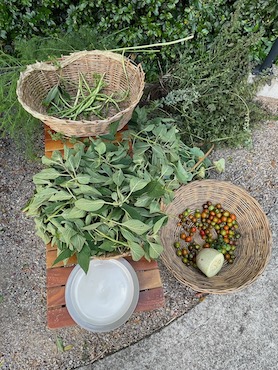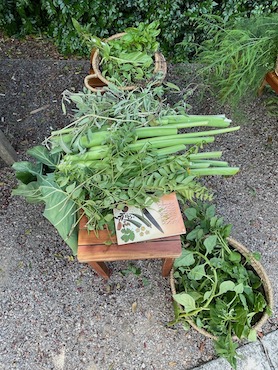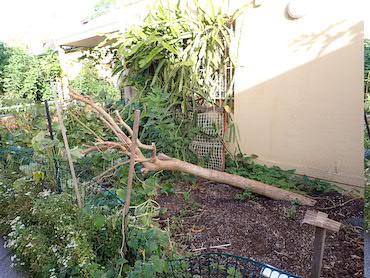On 12th February, we had a sunny and warm morning and 21 adults took advantage of it to work in the garden. The following week, 19th February, was cloudy. Twenty-two adults and one child came to the garden and worked. All but weather at both ends of the spectrum is great for gardening!
Since the start of this year, we’ve been lucky enough to gain some new members. While we’ve welcomed them at our gardening meetings, they haven’t (unfortunately!) been mentioned in our weekly updates. To do a bit of catch-up, we’d like to welcome Kathryn, Ana, Li and her children, Kathy, Djamileh (who has returned for a while after being away), Sussan, Nat and Joe. We hope they enjoy the garden and being part of our gardening community.
Snapshot
We harvested produce from our remaining summer plants. As we are moving closer to our autumn planting, both weeks were taken up largely with removing spent plants, weeding – many weeds love warm weather! – and tidying up garden beds. Quite a lot of watering was needed too because the garden beds dry out so quickly in the warm weather. Mulching with straw was continued to conserve moisture in the soil and keep the soil cooler.
On 12th February, we finalised our autumn planting list, thanks to some guidance from Jock, who recommended particular varieties of different cool season plants that had been more successful than other varieties in the past. These recommendations were possible because of the careful record keeping that has been done every season in our garden – again by Jock!
Harvest
Some of our harvest is shown below and included larger amounts of some herbs than usual, as we were tidying up the public garden bed, which contains mostly herbs. We harvested snake beans, French beans, cucumbers, spaghetti squash, eggplant, tomatoes, pineapple sage, oregano, sage, green basil, Thai basil, fennel, nasturtium, chickory, curry leaves and Warrigal greens.
Another plant we harvested – because it had grown so large that half of it was dug out – was Tahitian spinach or celery stem taro (Colocasia esculenta –https://greenharvest.com.au/Plants/Information/TahitianSpinach.html). This is in the right-hand photo below and is the thick green stems with very large leaves on the end.
One of our members, Loan, says that the stems of this plant are commonly used in south‑east Asian cooking (it needs to be cooked!) and uses it herself. It is typically used in fish soup, after first removing the very thin skin, slicing it into bite-sized pieces and then boiling in the fish soup stock for 3 minutes or so (for example,https://www.vickypham.com/blog/vietnamese-sweet-sour-tamarind-fish-soup-elephant-ear-taro-canh-chua-ca-bac-ha). It can also be used in stir fried dishes, where it is peeled and sliced and again cooked for about 3 minutes.


Sowing and planting
Some cosmos, a flowering annual in the daisy family (Asteraceae) was planted in various beds using saved seeds. Cosmos attracts bees, butterflies and beneficial insects and is pretty to look at too!
On 19th February, some green manure was planted in the bed in the secret garden where the potatoes were grown last year. We used a combination of cowpea (a legume) and Japanese millet (a grass). The legume adds nitrogen to the soil and both plants add organic matter, which helps soil to retain water and plant nutrients better. Cowpea also helps to control nematodes in the soil. Certain nematodes can attack the roots of plants in the Solanaceae family, like tomato, eggplant – and potato. In a few weeks, just as the cowpea starts to flower, we’ll slash these plants and leave this plant material on the bed to slowly rot down.
Special mention
One unfortunate notable event happened recently. Our tamarillo tree fell over! It was laden with fruit, which was all still green. The sad remains of the tree after the branches were removed to maintain access along the walkway are in the photo below. There were several kilos of green tamarillos collected, so, if anyone has a recipe for green tamarillos, there’s a good supply available if you’re quick!
Something else unusual – but much more pleasant – was a green bean dish, which Hana, one of our members, made and brought for us all to share. The beans are cooked very slowly – for half a day – with tomatoes and some spices, a method Hana says is typically used in Lebanon for cooking beans. The tender beans, eaten with flat bread, were delicious!
We all gave Michael the very best wishes for his recent birthday too!

Coming up in the garden
The cow manure has arrived! This can be dug in on our next workday to give the garden beds a bit more body for our autumn plantings. The seed order for our autumn planting is on the way, although we still have some seeds from previous years that should be viable and can be used too.
